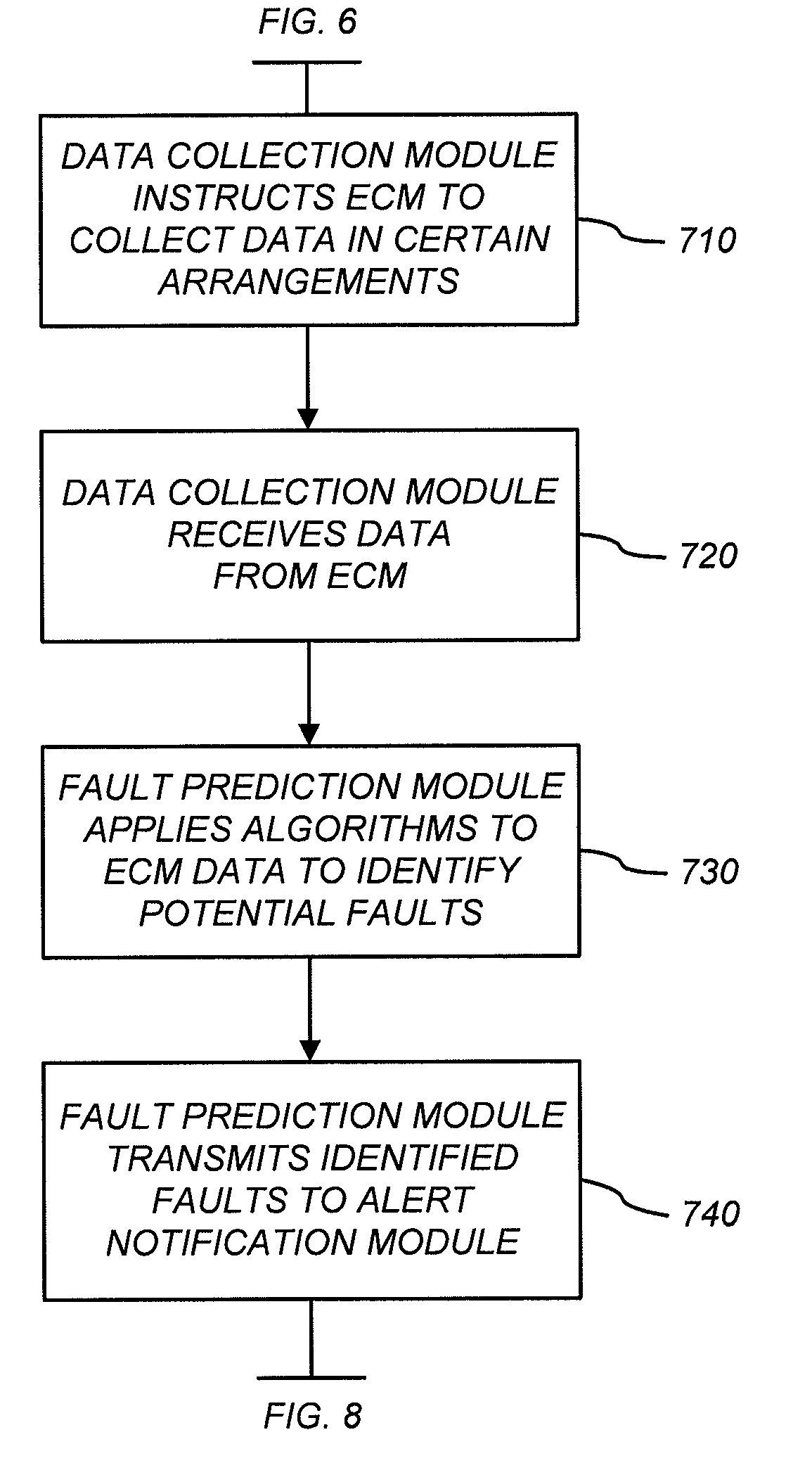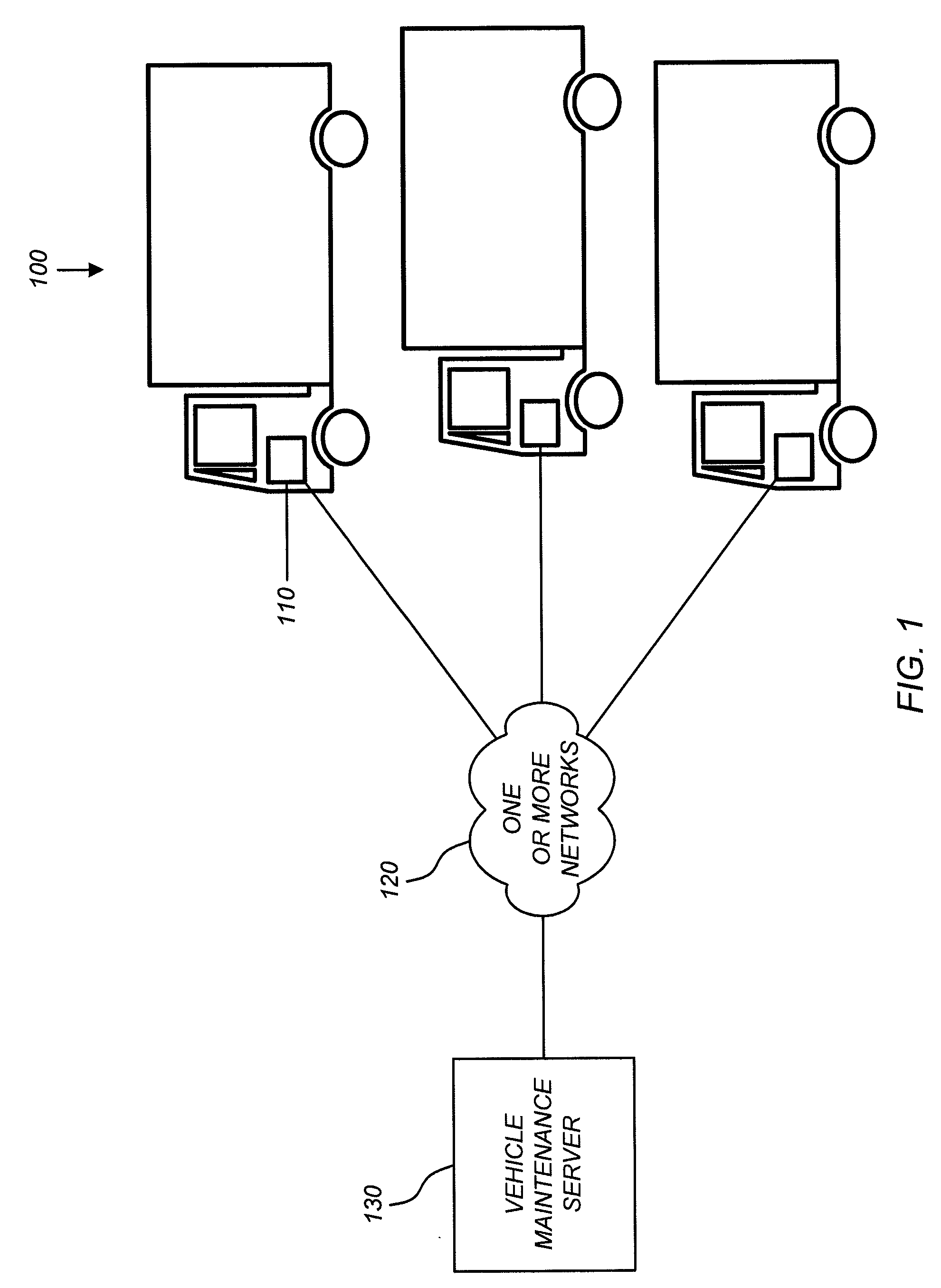[0009]Embodiments of the present invention provide an improvement over known maintenance systems by, among other things, providing a vehicle
maintenance system that is configured to provide one or more of the following advantages: (1) reduce the number of vehicle breakdowns, (2) reduce maintenance and repair costs, (3) reduce vehicle
downtime for maintenance and repairs, (4) increase vehicle efficiency and performance, and (5) increase vehicle lifetime.
[0010]In various embodiments of the present invention, a preventative vehicle
maintenance system is provided. The system includes a fleet of vehicles comprising a plurality of vehicles, an electronic control module (ECM) disposed in each of the plurality of vehicles within the fleet of vehicles, a computer processor adapted to execute a vehicle maintenance engine, and a memory coupled to the computer processor and adapted for storing the vehicle maintenance engine. Each of the ECMs is configured to collect data from one or more sensors disposed within the respective vehicle in which the ECM is disposed. The vehicle maintenance engine is configured for receiving from the sensor
signal data collected from the one or more sensors disposed within the respective plurality of vehicles, statistically analyzing data received from at least one type of sensor of the one or more sensors disposed within the plurality of vehicles to identify at least one earmark corresponding to a potential fault condition for one or more vehicle components associated with the at least one type of sensor, and individually comparing the sensor
signal data from the at least one type of sensor received from each of the plurality of vehicles to the identified earmark. If the received sensor
signal data from the at least one type of sensor for a particular one of the plurality of vehicles is within a particular range of the earmark, the vehicle maintenance engine is configured for generating an alert code for the particular vehicle. In response to generating the alert code, the vehicle maintenance engine is configured for repairing the one or more vehicle components for the particular vehicle to prevent the occurrence of a failure of the one or more vehicle components in advance.
[0011]In other various embodiments, a method for maintaining a vehicle is provided. The method begins with the step of receiving from a plurality of ECMs sensor signal data collected from a first type of sensor disposed within each of a plurality of vehicles, in which each ECM is disposed within a respective one of the plurality of vehicles. The method continues by determining a first statistical distribution of the sensor signal data from substantially all of the plurality of vehicles, determining a second statistical distribution for each of the plurality of vehicles of the sensor signal data from the first type of sensor from each of the plurality of vehicles, and statistically comparing each second statistical distribution for each of the plurality of vehicles to the first statistical distribution related to substantially all of the plurality of vehicles to determine a degree of difference between the statistical distributions. In response to the degree of difference being outside of a predetermined range based on the first statistical distribution for substantially all of the plurality of vehicles, the method generates an alert code for the particular vehicle. In response to generating the alert code, the method includes the step of repairing one or more vehicle components for the particular vehicle associated with the first type of sensor data to prevent the occurrence of a failure of the one or more vehicle components in advance.
[0012]In yet another embodiment, another method for maintaining a vehicle is provided. The method includes the steps of receiving from an ECM a first set of sensor signal data collected from one or more sensors disposed within a vehicle, the first set of sensor signal data being collected during a first time period, and receiving from the ECM a second set of sensor signal data collected from the one or more sensors disposed within the vehicle, the second set of sensor signal data being collected during a second time period. Next, the method continues by determining a statistical distribution of at least a portion of the first set of sensor signal data associated with a particular type of sensor, determining an average of at least a portion of the second set of sensor signal data associated with the particular type of sensor, and statistically comparing the average to the statistical distribution to determine a degree of difference between the average and the statistical distribution. In response to the degree of difference being outside of a predetermined range based on the statistical distribution of at least a portion of the first set of sensor signal data associated with the particular type of sensor, the method generates an alert code for the vehicle. In response to generating the alert code, the method includes the step of repairing one or more vehicle components for the vehicle associated with the first type of sensor data to prevent the occurrence of a failure of the one or more vehicle components in advance.
[0013]In another embodiment, another method for maintaining a vehicle is provided. The method begins with the step of receiving a first set of sensor signal data collected by a plurality of electronic control modules (ECM) during a first period of time. Each ECM is disposed within a respective vehicle of a plurality of vehicles, and the sensor signal data collected by each ECM is collected from one or more sensors disposed within the respective vehicle in which the respective ECM is disposed. The method continues with the steps of statistically analyzing at least a portion of the first set of sensor signal data collected from at least one type of sensor of the one or more sensors to identify at least one earmark corresponding to a potential fault condition for one or more vehicle components associated with the at least one type of sensor, receiving sensor signal data collected by the plurality of ECMs during a second period of time, and individually comparing at least a portion of the sensor signal data collected from the at least one type of sensor from each of the plurality of vehicles to the identified earmark. In response to the least a portion of the sensor signal data from a particular vehicle of the plurality of vehicles being within a particular range of the earmark, an alert code is generated for the particular vehicle. In response to generating the alert code, the method includes the step of repairing the one or more vehicle components for the particular vehicle to prevent the occurrence of a failure of the one or more vehicle components in advance of the failure of the one or more components.
 Login to View More
Login to View More  Login to View More
Login to View More 


